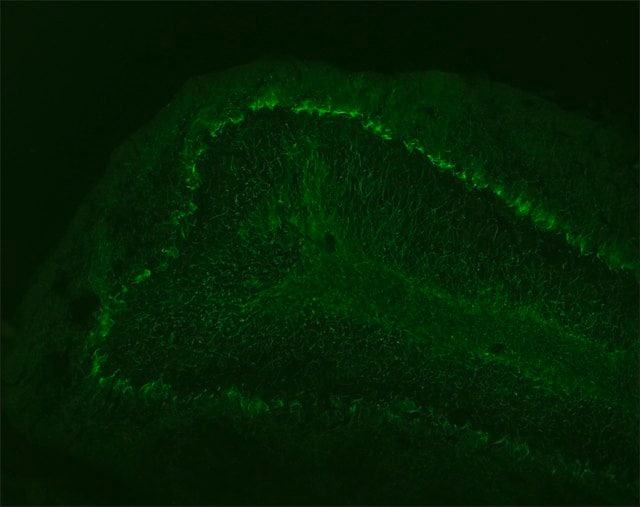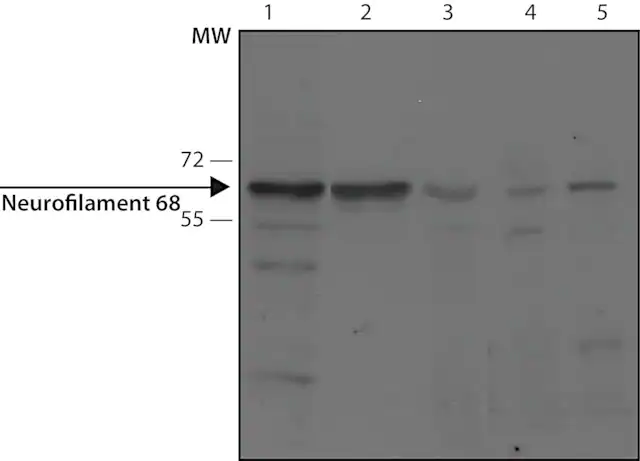您的位置:首页 > 产品中心 > Monoclonal Anti-Neurofilament 68 antibody produced in mouse
Monoclonal Anti-Neurofilament 68 antibody produced in mouse

产品别名
Monoclonal Anti-Neurofilament 68 antibody produced in mouse
Monoclonal Anti-Neurofilament light chain
基本信息
| MDL number | MFCD02097017 |
| NACRES | NA.41 |
| General description【一般描述】 | Monclonal Anti-Neurofilament 68 (mouse IgG1 isotype) is produced by the fusion mouse myeloma cells and splenocytes from an immunized mouse. Neurofilaments are composed of three sub-units- light NFL protein, medium NFM protein, heavy NFH protein. Along with there two other intermediate filaments are present α-internexin and peripherin. Neurofilaments are phosphoproteins. The neurofilaments are one of the five major groups of IFs and are found predominantly in cells or tissues of neuronal origin. They are composed of three major proteins of apparent molecular weights 68 kD, 95kD, and 115kD. Neurofilament proteins are synthesized in the neuronal perikarya, assembled to form filaments and then slowly transported within the axons towards the synaptic terminals. |
| Specificity【特异性】 | The antibody reacts specifically with neurofilament 68 in cultured cells or tissue preparations originating from human, pig, rat or chicken. It does not cross react with other intermediate filament proteins. |
| Immunogen【免疫原】 | pig spinal cord. |
| Application【应用】 | Monoclonal Anti-Neurofilament 68 antibody has been used:
Mouse Monoclonal clone NR4 anti-Neurofilament 68 antibody may be used for the localization of the neurofilament of molecular weight equal to 68,000 while being non-reactive with other intermediate filament proteins. |
| Biochem/physiol Actions【生化/生理作用】 | Neurofilaments undergo post-translational modification, which results in their heterogeneity, including different levels of phosphorylation. The phosphorylation of neurofilament polypeptides has been suggested to modulate their function by influencing the interaction between neurofilament and cytoplasmic organelles. Neurofilaments play a role in axonal calibre as they help in movement of an impulse down the axon. Their activity depends on phosphorylation of neurofilaments.Mutations of neurofilaments causes Charcot-Marie-Tooth (CMT) disease. Accumulation of neurofilaments has been observed in many human neurological diseases like Alzheimer′s disease, progressive supranuclear palsy, diabetic neuropathy, and giant axonal neuropathy. |
产品性质
| Quality Level【质量水平】 | 200 |
| biological source【生物来源】 | mouse |
| conjugate【偶联物】 | unconjugated |
| antibody form【抗体形式】 | ascites fluid |
| antibody product type | primary antibodies |
| clone【克隆】 | NR4, monoclonal |
| mol wt【分子量】 | antigen apparent mol wt 68 kDa |
| contains【包含】 | 15 mM sodium azide as preservative |
| species reactivity | pig, chicken, rat, human |
| technique(s) | immunohistochemistry (formalin-fixed, paraffin-embedded sections): 1:40 using rat cerebellum microarray: suitable western blot: 1:500 using bovine spinal cord neurofilament |
| isotype【同位素/亚型】 | IgG1 |
| UniProt accession no.【UniProt登记号】 | P07196 |
| shipped in【运输】 | dry ice |
| storage temp.【储存温度】 | −20℃ |
| Gene Information | human ... NEFL(4747) |
产品说明
| Disclaimer【免责声明】 | Unless otherwise stated in our catalog or other company documentation accompanying the product(s), our products are intended for research use only and are not to be used for any other purpose, which includes but is not limited to, unauthorized commercial uses, in vitro diagnostic uses, ex vivo or in vivo therapeutic uses or any type of consumption or application to humans or animals. |
安全信息
| Storage Class Code【储存分类代码】 | 12 - Non Combustible Liquids |
| WGK | WGK 1 |





